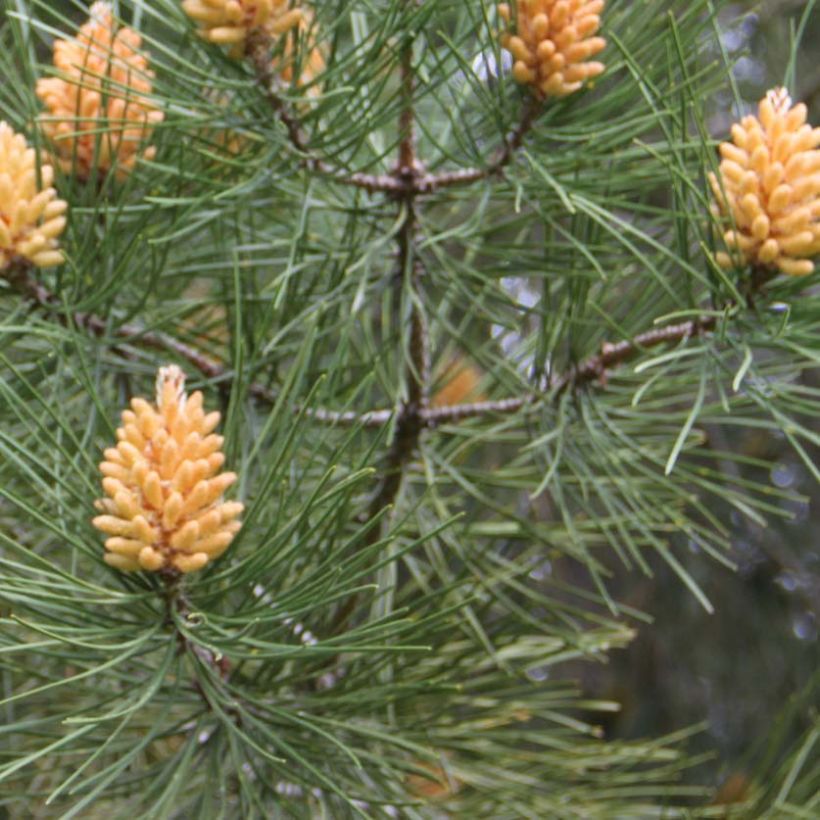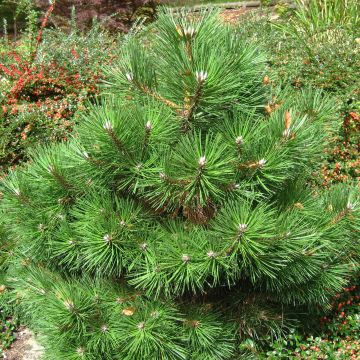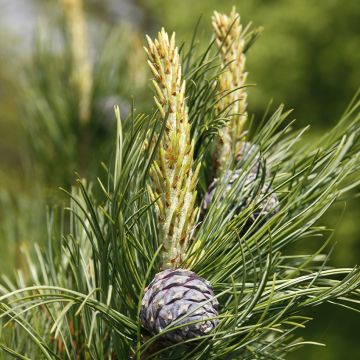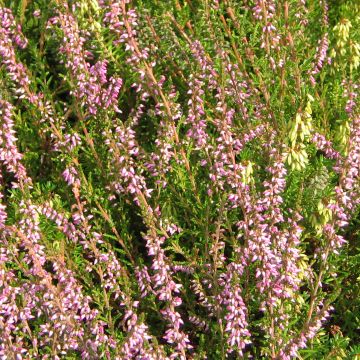

Pinus pinaster - Maritime pine


Pinus pinaster - Maritime pine


Pinus pinaster - Maritime pine
View more pictures
Hide images

Vincent V.

This is a 10L pot.
Vincent V. • BE
Pinus pinaster - Maritime pine
Pinus pinaster
Maritime Pine
Special offer!
Receive a €20 voucher for any order over €90 (excluding delivery costs, credit notes, and plastic-free options)!
1- Add your favorite plants to your cart.
2- Once you have reached €90, confirm your order (you can even choose the delivery date!).
3- As soon as your order is shipped, you will receive an email containing your voucher code, valid for 3 months (90 days).
Your voucher is unique and can only be used once, for any order with a minimum value of €20, excluding delivery costs.
Can be combined with other current offers, non-divisible and non-refundable.
Home or relay delivery (depending on size and destination)
Schedule delivery date,
and select date in basket
This plant carries a 24 months recovery warranty
More information
We guarantee the quality of our plants for a full growing cycle, and will replace at our expense any plant that fails to recover under normal climatic and planting conditions.
Would this plant suit my garden?
Set up your Plantfit profile →
Description
Pinus pinaster, or Maritime Pine, is a beautiful tree with a vertical trunk and a rounded crown. With a trunk often bare at the base, covered with a rough grey to red bark and a light canopy, it has an irregular, rather flat and spread out crown, visible from afar. Although native to North Africa and southern Europe, it requires fresh, sandy, deep, well-drained soil. Capable of reaching a height of 30 m (98.4 ft) in just a few decades, this tall tree is reserved for large gardens!
Pinus pinaster, also known as Corsican Pine or Mediterranean Pine, is a tall conifer of the Pinaceae family. It is native to Tunisia, Algeria, and Morocco. Planted on a large scale under Napoleon III to create the Landes forest, it has found a climate and soil on the Atlantic coast that suits it perfectly. Maritime Pine, prized for its wood and resin, is a forest species of major economic importance for southwestern Europe.
It can reach a height of 20 m to 30 m (66 ft to 98.4 ft) with a spread of 15 m (49.2 ft) and quickly reaches maturity at around 40 or 50 years old. Fast-growing, when young it has a conical shape and then its crown takes on a beautiful rounded shape. Over time, its massive and very straight trunk becomes bare at the base, revealing a thick, reddish-brown bark that is deeply cracked and channelled, giving it a scaly appearance. The evergreen needles are thick and rigid, and are grouped in pairs. They measure 10 cm to 20 cm (3.9 in to 7.9 in) in length. Their colour is a shiny dark green, then they turn a tawny hue before falling. This tree first develops a deep root system, to withstand the wind, and then numerous trailing surface roots. Cone production occurs 5 to 6 years after sowing, in April-May. Each individual bears clusters of small male cones, scaly and covered in yellow pollen, and female cones, located at the top of the crown, which will transform into cones 10 cm to 18 cm (3.9 in to 7.1 in) in length, oblong in shape and reddish in colour, with a shiny finish.
Maritime Pine is a beautiful subject to plant as a standalone in the centre of a lawn or in a grove at the boundaries of a large property. It appreciates warm and sunny exposures, and deep, light, well-drained soils. Widely used for its resistant wood and resin, a preferred raw material for the production of turpentine, it is valuable for stabilising unstable and sandy soils. It suits larger gardens, where it will provide shade in summer and interest in winter. It tolerates rocky and even slightly calcareous soils perfectly and is well-suited to coastal areas with salt spray.
Report an error about the product description
Pinus pinaster - Maritime pine in pictures




Plant habit
Flowering
Foliage
Botanical data
Pinus
pinaster
Pinaceae
Maritime Pine
Mediterranean
Other Pinus - Pine
View all →Planting and care
Plant Pinus pinaster from September to November and from February to June in deep, well-drained, moist, preferably slightly acidic or neutral soil. A sandy, humus-rich or loamy soil will be perfect. Choose a sunny and open location, anticipating the space the tree will take. Soak the root balls well before planting. Stake the young plants to give them a good start. Add organic matter at planting and water generously in the first years, and during prolonged drought. Apply a special conifer fertiliser every year in April and weed the soil in summer. This hardy conifer (up to -15° C (5° F)) is sensitive to severe frost when young. While it can withstand occasional drought once established, it generally dislikes hot summers inland. Pruning is not necessary.
Planting period
Intended location
Care
This item has not been reviewed yet - be the first to leave a review about it.
Similar products
Haven't found what you were looking for?
Hardiness is the lowest winter temperature a plant can endure without suffering serious damage or even dying. However, hardiness is affected by location (a sheltered area, such as a patio), protection (winter cover) and soil type (hardiness is improved by well-drained soil).

Photo Sharing Terms & Conditions
In order to encourage gardeners to interact and share their experiences, Promesse de fleurs offers various media enabling content to be uploaded onto its Site - in particular via the ‘Photo sharing’ module.
The User agrees to refrain from:
- Posting any content that is illegal, prejudicial, insulting, racist, inciteful to hatred, revisionist, contrary to public decency, that infringes on privacy or on the privacy rights of third parties, in particular the publicity rights of persons and goods, intellectual property rights, or the right to privacy.
- Submitting content on behalf of a third party;
- Impersonate the identity of a third party and/or publish any personal information about a third party;
In general, the User undertakes to refrain from any unethical behaviour.
All Content (in particular text, comments, files, images, photos, videos, creative works, etc.), which may be subject to property or intellectual property rights, image or other private rights, shall remain the property of the User, subject to the limited rights granted by the terms of the licence granted by Promesse de fleurs as stated below. Users are at liberty to publish or not to publish such Content on the Site, notably via the ‘Photo Sharing’ facility, and accept that this Content shall be made public and freely accessible, notably on the Internet.
Users further acknowledge, undertake to have ,and guarantee that they hold all necessary rights and permissions to publish such material on the Site, in particular with regard to the legislation in force pertaining to any privacy, property, intellectual property, image, or contractual rights, or rights of any other nature. By publishing such Content on the Site, Users acknowledge accepting full liability as publishers of the Content within the meaning of the law, and grant Promesse de fleurs, free of charge, an inclusive, worldwide licence for the said Content for the entire duration of its publication, including all reproduction, representation, up/downloading, displaying, performing, transmission, and storage rights.
Users also grant permission for their name to be linked to the Content and accept that this link may not always be made available.
By engaging in posting material, Users consent to their Content becoming automatically accessible on the Internet, in particular on other sites and/or blogs and/or web pages of the Promesse de fleurs site, including in particular social pages and the Promesse de fleurs catalogue.
Users may secure the removal of entrusted content free of charge by issuing a simple request via our contact form.
The flowering period indicated on our website applies to countries and regions located in USDA zone 8 (France, the United Kingdom, Ireland, the Netherlands, etc.)
It will vary according to where you live:
- In zones 9 to 10 (Italy, Spain, Greece, etc.), flowering will occur about 2 to 4 weeks earlier.
- In zones 6 to 7 (Germany, Poland, Slovenia, and lower mountainous regions), flowering will be delayed by 2 to 3 weeks.
- In zone 5 (Central Europe, Scandinavia), blooming will be delayed by 3 to 5 weeks.
In temperate climates, pruning of spring-flowering shrubs (forsythia, spireas, etc.) should be done just after flowering.
Pruning of summer-flowering shrubs (Indian Lilac, Perovskia, etc.) can be done in winter or spring.
In cold regions as well as with frost-sensitive plants, avoid pruning too early when severe frosts may still occur.
The planting period indicated on our website applies to countries and regions located in USDA zone 8 (France, United Kingdom, Ireland, Netherlands).
It will vary according to where you live:
- In Mediterranean zones (Marseille, Madrid, Milan, etc.), autumn and winter are the best planting periods.
- In continental zones (Strasbourg, Munich, Vienna, etc.), delay planting by 2 to 3 weeks in spring and bring it forward by 2 to 4 weeks in autumn.
- In mountainous regions (the Alps, Pyrenees, Carpathians, etc.), it is best to plant in late spring (May-June) or late summer (August-September).
The harvesting period indicated on our website applies to countries and regions in USDA zone 8 (France, England, Ireland, the Netherlands).
In colder areas (Scandinavia, Poland, Austria...) fruit and vegetable harvests are likely to be delayed by 3-4 weeks.
In warmer areas (Italy, Spain, Greece, etc.), harvesting will probably take place earlier, depending on weather conditions.
The sowing periods indicated on our website apply to countries and regions within USDA Zone 8 (France, UK, Ireland, Netherlands).
In colder areas (Scandinavia, Poland, Austria...), delay any outdoor sowing by 3-4 weeks, or sow under glass.
In warmer climes (Italy, Spain, Greece, etc.), bring outdoor sowing forward by a few weeks.


















































